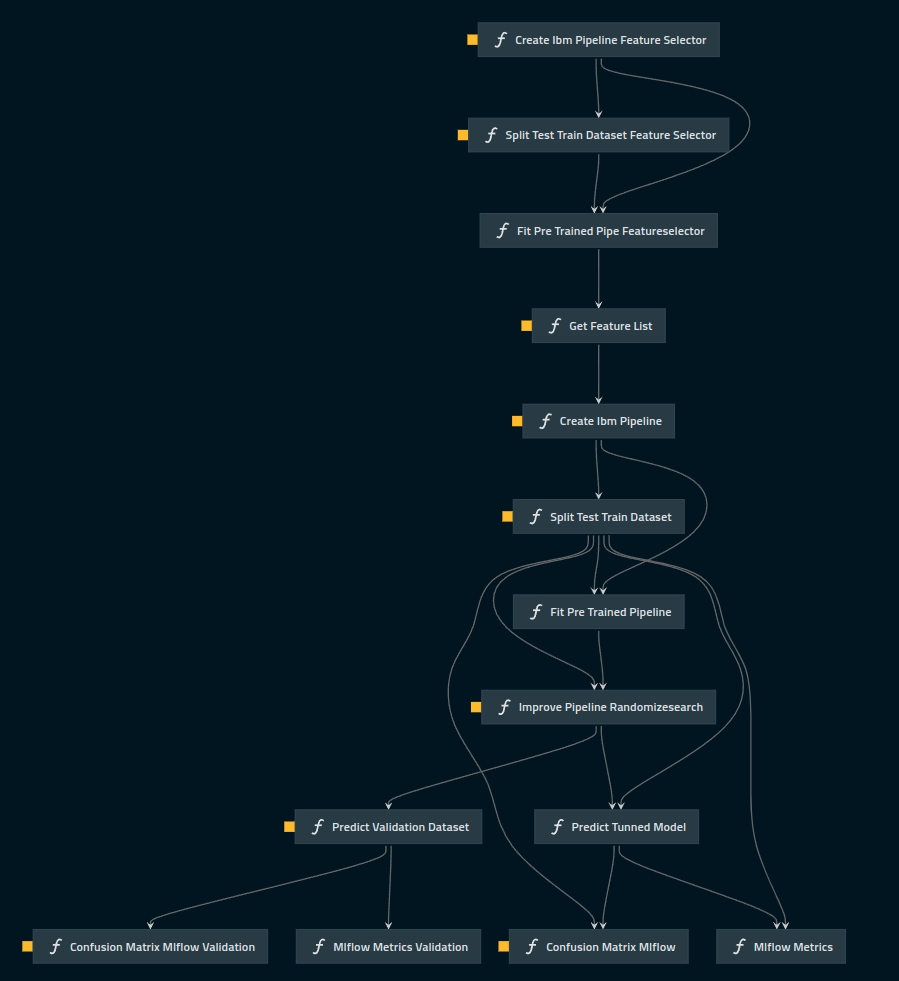Please if you'vent read (README), please go back and follow the stpes to install and undertanding how Kedro Works
- Minimize the costs from a company with Maintance
- Build a scalable machine learning model with integrated and open tested pipelines using Kedro
The data is Split in Validation Dataset (2020) and Train Dataset (Pre 2020)· All columns for bureaucratic reasons are coded. For this reason any AED would’nt be so useful to undertand the problema. Caracteristcis columns:
- 171 Columnas ( type: ‘Object’)
- 1 Feature Target ( Column: ‘class’)
- 170 Feature Training (insted missing value, has a string ‘na’ )
This is a classic classification problem, where the costs of pos-maintance are expensive then pre-mantaince where recall metric is the fit for the problem. So was create a cost function that need be minimize. How our data is non-balance data (98% - negative - 2% - pos) i used undersample technique to keep the caracteristics of ‘pos’ samples.
- Feature Selection
- Classifier ML
- Validation Results
As coded columns and an analysis of them difficult to interpret, it was created a pipeline to find the best features that will be use the classifier_ml. 4 Steps to complet all the imblearn.pipeline.
Preprocessing:
- 1- ReplaceStr - Replace ‘na’ to np.Nan (missing Values).
- 2- CastFeature - Transform columns object to Float
- 3- Imputer - Replace missing values (np.Nan) by the medium.
UnderSample
-
RandomUnderSampler - How our data is non-balance data (98% - negative - 2% - pos), i used undersample tecicnique to mantein the caracteristics of ‘pos’ samples.
SequentialFeatureSelector
- To deal with so many features, was used SequentialFeatureSelector and RandomForest, to find the best features. Was used randomforest because bootstrap method would deal well with the probleam. (Many coluns coded ).
- https://scikit-learn.org/stable/modules/generated/sklearn.feature_selection.SequentialFeatureSelector.html
Output - Feature Selection:
- It's list with 10 best features.
Preprocessing: Sabe from Feature Selection.
Feature Engineering:
- PolynomialFeatures() -> Now having 10 columns it's possible create new features.
https://scikit-learn.org/stable/modules/generated/sklearn.preprocessing.PolynomialFeatures.html
GradientBoostingClassifier
- Now having good features, was used a greedy model to find the best classification model.
- RandomizeSearch will use a cost funcion to be minimize.
Will use the trained_tuned_model from classifier ML to predict the Data from (data_2020, in catalog.) The resulst are in Mlflow
This is your new Kedro project, which was generated using Kedro 0.18.0.
Take a look at the Kedro documentation to get started.
In order to get the best out of the template:
- Don't remove any lines from the
.gitignorefile we provide - Make sure your results can be reproduced by following a data engineering convention
- Don't commit data to your repository
- Don't commit any credentials or your local configuration to your repository. Keep all your credentials and local configuration in
conf/local/
Declare any dependencies in src/requirements.txt for pip installation and src/environment.yml for conda installation.
To install them, run:
pip install -r src/requirements.txt
You can run your Kedro project with:
kedro run
Have a look at the file src/tests/test_run.py for instructions on how to write your tests. You can run your tests as follows:
kedro test
To configure the coverage threshold, go to the .coveragerc file.
Note: Using
kedro jupyterorkedro ipythonto run your notebook provides these variables in scope:context,catalog, andstartup_error.Jupyter, JupyterLab, and IPython are already included in the project requirements by default, so once you have run
pip install -r src/requirements.txtyou will not need to take any extra steps before you use them.
To use Jupyter notebooks in your Kedro project, you need to install Jupyter:
pip install jupyter
After installing Jupyter, you can start a local notebook server:
kedro jupyter notebook
